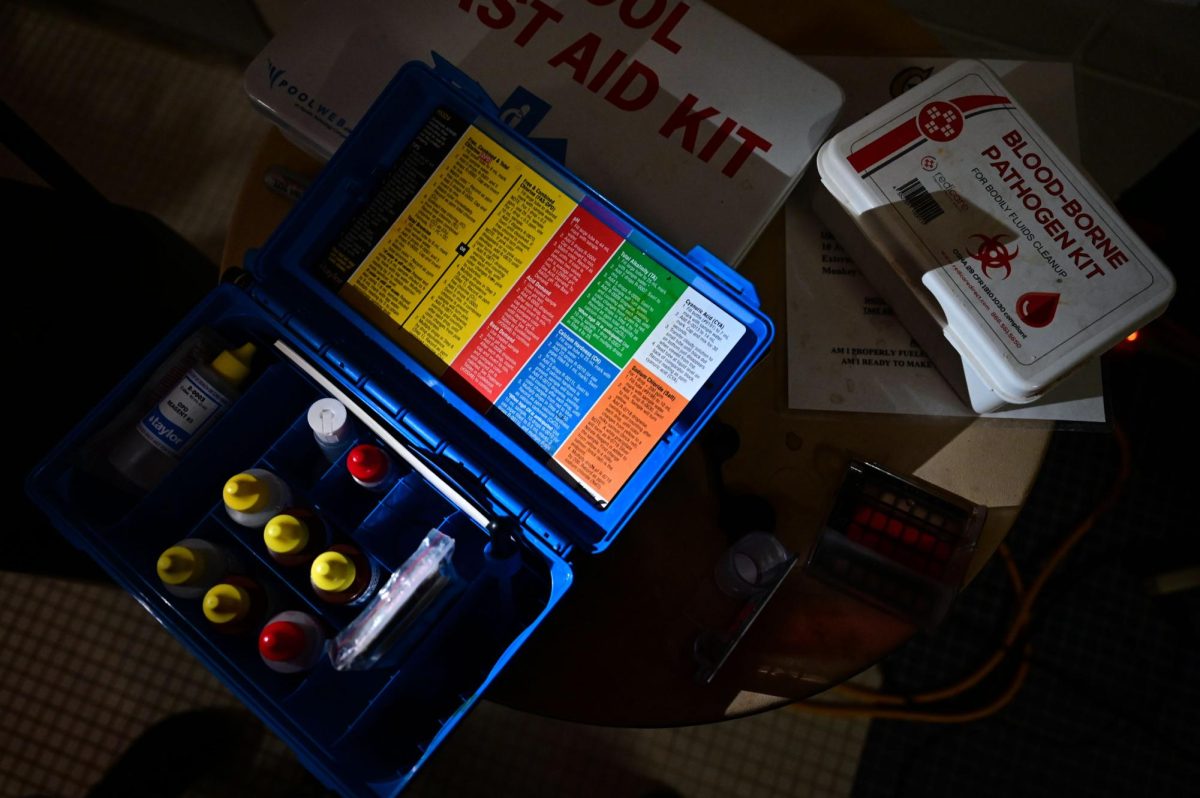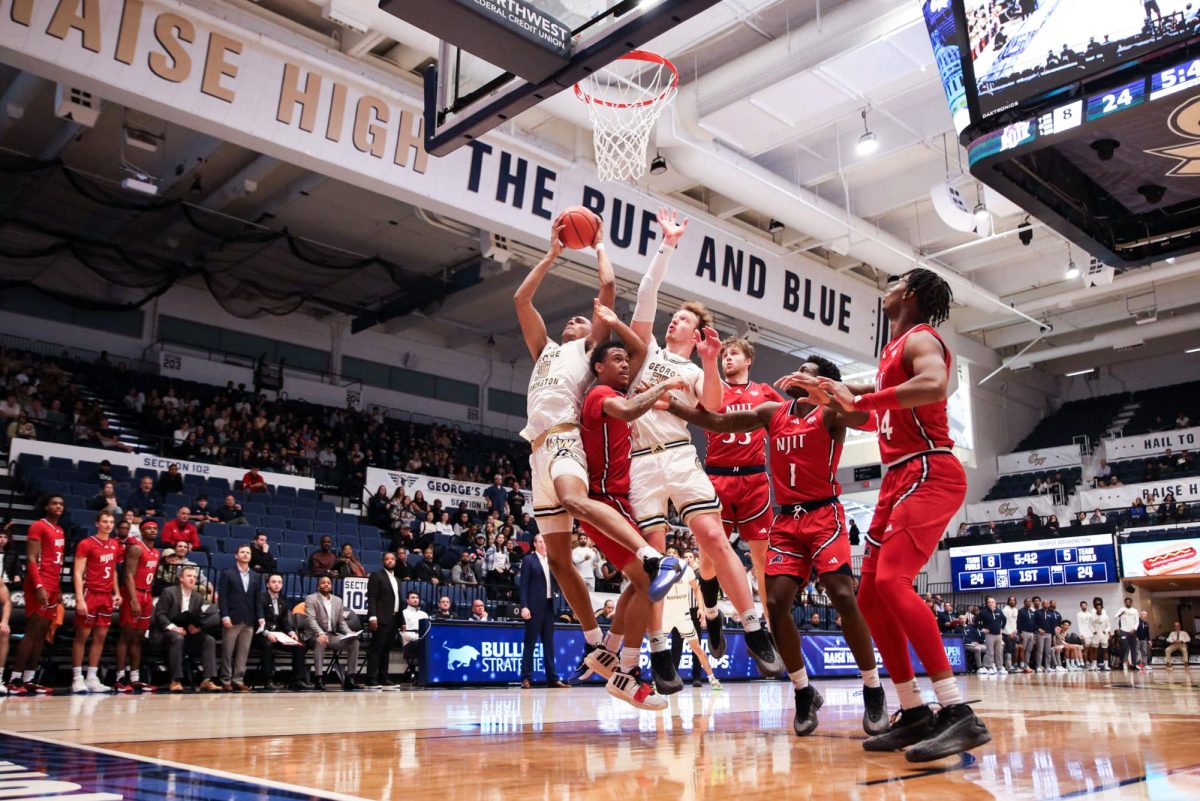As the GW men’s basketball team took the floor last week for its final home game of the year against St. Joseph’s, the student section of the Smith Center was again packed to capacity, a testament to the buzz the team has created on campus.
Just as notable, though, was the scene courtside, where the stands were nearly filled with ticket holders of all sorts of stripes – alumni, middle-aged couples, young professionals and families – paying up to $600 for a seat. Perhaps more important still were those spectators not in the arena: the tens of thousands of viewers across the country who watched the game on ESPN2.
The season-end sellout was just one of several in what has been a season of uncommon attention for the Colonials. Though they would lose 71-56 against St. Joe’s, the Colonials are having their best season since the late 1990s and are among the favorites to win the Atlantic 10 Tournament this weekend. While the impact on school spirit has been obvious, the success has also created a burst of public visibility for the program and the University that many administrators are relishing.
And while GW may or may not receive an NCAA Tournament bid on Sunday, the team’s resurgence has been great for the school, administrators said.
“I think it’s phenomenal for the school,” said Dom Perno, assistant athletic director for advancement. “What’s happened in the world of athletics at GW is that it’s what’s in your face – it’s what’s in the papers all the time, it’s what’s on TV, and it’s how people are hearing about the University.”
With the excitement surrounding this year’s team, administrators have seen a renewed interest in the school coming from all different areas. Officials attribute the attention to the nature of American college sports and the media coverage it garners. That kind of environment provides a prime opportunity for schools to use athletics as a way to boost their profile and create revenue opportunities.
“If you have a game on for two hours on national television, you couldn’t buy two hours of advertising time on ESPN to advertise George Washington University,” said Robert Chernak, senior vice president for Student and Academic Support Services. “You couldn’t afford to take out a full page ad in The Washington Post, like we get every time we play. It’s a lot of media attention, a lot of publicity, and you hope it’s good.”
With the heavy costs associated with collegiate football, smaller schools like GW have historically turned to basketball as the anchor for its athletics program, where success can do wonders for a school’s name recognition. Last year, when GW rival St. Joe’s went 30-2 and made it to the fourth round of the NCAA Tournament, television crews were a daily fixture on campus, allowing officials to promote their school.
“There was a very nice carryover effect that allowed us to show a much broader range of people what St. Joe’s was about,” said Saint. Joseph’s University spokesman Tom Durso. “Every time we had a camera in front of us we talked about how great it was not only from a basketball perspective but from a university perspective.”
For this year’s GW squad, the buzz began before the season started, when several national media members, including ESPN.com’s Andy Katz, named GW as an up-and-coming team. The Colonials played five nationally televised games, including their season opener against Wake Forest, compared to just one last season. The hype hit its peak when GW launched into a six-week run in the Associated Press Top 25 poll after beating Michigan State University and Maryland, and talk of an NCAA postseason bid was rampant.
Brightening the spotlight were tidbits of recognition from around the sports-media complex. Officials point to blurbs about the team in several sports magazines, a pair of appearances ESPN’s Plays of the Day and regular features on SportsCenter, where anchor Scott Van Pelt has taken a liking to sounding out “Pops Men-sah-Bon-su.”
“All of that is significant,” Perno said. “All of these things generate interest, generate more money, and there’s no doubt that that interest is far more significant than it was six or seven years ago.”
The trick for the University is to translate that interest into revenue, and administrators say they’re already seeing an impact. The average attendance at the Smith Center has increased from 2,615 in 2001-02 to 3,757 this season, and season ticket sales are up to more than 1,800 from 1,300 last year. Bob Zurfluh, assistant athletic director for marketing and promotions, said he’s seen a flurry of new corporate sponsors hoping to capitalize on the renewed enthusiasm.
“When we visit potential partners now, they know about the program, they’ve heard about it,” Zurfluh said. “In past years when we’ve approached them, they may have heard of us, but it wasn’t nearly as high up on their radar screen as it is now.”
The publicity also has a significant impact in courting alumni donations. The national television exposure has allowed the school to organize more alumni watch parties in cities with high populations of graduates. Officials said participation is up considerably, particularly among young alumni, creating prime opportunities to attract new benefactors.
“It’s a great hook for us,” said Stacy Martin, senior director of advancement for alumni programs. “It’s a good way to get in the door with alumni and then use those opportunities for fundraising in the future. A good basketball team certainly makes it easier.”
Though they welcome the attention, officials are quick to note the limitations of promoting the school through basketball. Several noted that athletics is just one part of the University and should not outshine academics. They added that they have no ambitions of joining the ranks of schools such as Duke University and Syracuse University, where basketball is a cornerstone.
However, administrators do recognize what a successful basketball team can provide, and they have lofty expectations for the future. With just two departing seniors, officials are buzzing about the possibility of a preseason ranking next year and all but guarantee a 2006 bid in the NCAA Tournament. And as the program builds, they hope, so will the opportunities for the University as a whole.
“That’s dollars for you,” said Perno. “That’s bigger enrollment numbers, that’s bigger attendance at all the games, that’s bigger interest in admissions. Everything is reflected in that type of setting, and the value is big.”






